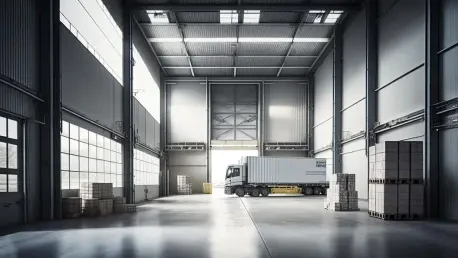Understanding the Logistics Industry Landscape
The logistics industry stands as a cornerstone of global trade, orchestrating the movement of goods across continents with an intricate network of supply chains that fuel economies worldwide. This vast sector, responsible for transporting everything from raw materials to consumer products, underpins the seamless functioning of markets by ensuring timely delivery and inventory management. Its significance cannot be overstated, as disruptions in logistics ripple through industries, affecting costs, availability, and consumer satisfaction on a massive scale.
Key segments such as maritime shipping, warehousing, and trucking form the backbone of this ecosystem, each supported by major market players who drive innovation and competition. Technological advancements like automation, real-time tracking, and data analytics have transformed operations, enabling faster decision-making and improved visibility across supply chains. From autonomous vehicles in trucking to robotic systems in warehouses, technology has reshaped how goods are handled and transported, setting new benchmarks for speed and precision.
Yet, the scale of logistics operations demands unrelenting efficiency and stringent safety measures in an environment where margins are tight and competition is fierce. With billions of tons of cargo moved annually, even minor errors can lead to significant financial losses or safety hazards. The industry faces constant pressure to optimize processes while maintaining reliability, highlighting the critical balance between innovation and risk management in this dynamic field.
The Paradox of Technology and Persistent Errors
Technological Advancements in Logistics
In recent years, logistics has embraced cutting-edge tools to revolutionize operations and minimize risks. Artificial intelligence-driven analytics now forecast demand and optimize routes, while telematics and sensors provide real-time insights into vehicle conditions and cargo status. Digital twins—virtual replicas of physical systems—allow companies to simulate and troubleshoot scenarios before they unfold, aiming to enhance safety and efficiency across the board.
These innovations are designed to curb human error by automating repetitive tasks and delivering actionable data instantly. For instance, automated warehouse systems reduce manual handling mishaps, while GPS and sensor networks alert drivers to potential hazards on the road. The push for such technologies is fueled by evolving consumer expectations, with demands for faster deliveries and full transparency driving companies to adopt sophisticated tracking and communication tools.
As these advancements proliferate, the industry seeks to build a more resilient framework where errors are anticipated and mitigated through proactive measures. However, the rapid integration of technology also raises questions about its effectiveness when foundational challenges remain unaddressed, setting the stage for a deeper exploration of why mistakes persist despite such progress.
Evidence of Recurring Mistakes
Despite the influx of advanced tools, logistics continues to grapple with preventable incidents that undermine operational gains. Ship collisions, often due to misread navigation data, warehouse accidents from equipment misuse, and truck rollovers linked to driver oversight are reported with alarming regularity. Industry studies indicate that accident rates in certain sectors, such as maritime transport, have shown little improvement over the past decade, with financial losses running into billions annually.
Specific cases paint a grim picture of the human and economic toll. For example, recent investigations into port accidents reveal that over 30% of incidents stem from inadequate safety protocols, even when real-time monitoring systems are in place. These recurring failures suggest a disconnect between the availability of technology and its practical application, leaving stakeholders to question why error rates remain stubbornly high.
The stagnation in safety outcomes points to deeper systemic flaws that technology alone cannot resolve. While tools offer potential solutions, their impact is diminished when integration lacks alignment with human behavior and procedural rigor. This persistent gap underscores the need to look beyond gadgets and examine the broader context of operational failures.
Root Causes of Logistics Mistakes
The recurrence of errors in logistics often traces back to systemic issues that technology cannot fully address without complementary reforms. Human error remains a dominant factor, frequently worsened by insufficient training that fails to adapt to new tools or dynamic environments. Operators may misjudge situations or mishandle equipment, not due to incompetence, but because training programs are static and fail to instill situational awareness.
Beyond individual lapses, poor safety management and equipment neglect compound the risks. Cost-cutting measures often lead to deferred maintenance of critical machinery like cranes or forklifts, resulting in mechanical failures at critical moments. Communication breakdowns across teams further aggravate the problem, as unclear instructions or hierarchical barriers prevent timely interventions, turning minor oversights into major disasters.
Cultural complacency within the industry also plays a significant role, with technology often viewed as a cure-all rather than a tool requiring disciplined use. This mindset overlooks underlying procedural gaps, allowing risks to fester. Addressing these challenges requires robust strategies, such as enhanced, continuous training programs tailored to real-world scenarios and stricter maintenance schedules enforced without compromise, to build a foundation where technology can truly thrive.
Regulatory and Compliance Challenges
Navigating the regulatory landscape in logistics reveals a complex web of safety standards, hazardous material handling rules, and licensing requirements aimed at safeguarding operations. These frameworks, spanning national and international jurisdictions, set benchmarks for everything from cargo securing to driver qualifications, intending to minimize risks in a high-stakes industry. However, the effectiveness of these regulations often hinges on their implementation rather than their existence.
A significant gap persists between compliance on paper and in practice, with many companies treating regulations as mere formalities rather than integral values. Safety audits may be completed superficially, and hazardous material protocols are sometimes ignored under time pressures, exposing operations to preventable dangers. This checkbox mentality diminishes the protective intent of regulations, leaving vulnerabilities unchecked.
Weak enforcement and cultural resistance to safety protocols further erode compliance efforts, as penalties fail to deter negligence in some regions. To bridge this divide, solutions like regular, unannounced audits and the adoption of internal standards that surpass legal minimums can foster accountability. Embedding compliance into company culture, rather than viewing it as an external burden, remains essential for lasting improvement in safety outcomes.
Future Directions for Error Prevention
Envisioning a safer logistics sector requires a harmonious integration of technology and human systems to preempt mistakes before they occur. Emerging solutions, such as automated response systems that halt operations during detected anomalies, hold promise for immediate risk mitigation. Continuous learning platforms can also keep personnel updated on evolving risks, while AI-driven safety alerts provide real-time warnings tailored to specific conditions.
Beyond tools, cultural shifts toward transparency and shared knowledge are critical to breaking the cycle of errors. Encouraging open dialogue about near-misses and incidents across organizations can build collective intelligence, preventing recurrence through proactive measures. This approach transforms safety from a reactive obligation into a collaborative priority, aligning teams around a common goal.
Global economic trends, evolving regulations, and ongoing innovation will shape the trajectory of logistics safety in the coming years. As companies adapt to these drivers, a focus on operational resilience—through diversified processes and robust contingency planning—can ensure stability amid uncertainty. Prioritizing such strategies positions the industry to not only reduce errors but also enhance trust and reliability in an increasingly demanding market.
Conclusion and Call to Action
Reflecting on the persistent challenges in logistics, it becomes evident that mistakes endure despite technological strides due to entrenched human, systemic, and cultural barriers. The analysis highlighted how inadequate training, poor safety management, and superficial compliance undermine the potential of advanced tools, allowing preventable incidents to recur with costly consequences.
Looking ahead, actionable steps emerge as vital for stakeholders to disrupt this cycle. Investing in dynamic, ongoing training programs that adapt to real-world complexities is seen as a cornerstone for empowering personnel. Simultaneously, enforcing rigorous maintenance and fostering open communication across hierarchies stand out as practical measures to bolster safety.
Moreover, a renewed commitment to integrating technology with disciplined oversight is deemed essential. By championing internal standards that exceed regulatory baselines and sharing lessons learned industry-wide, logistics firms can cultivate resilience and trust. These efforts, grounded in a proactive safety ethos, promise to pave the way for sustainable growth and reliability in a critical global sector.









